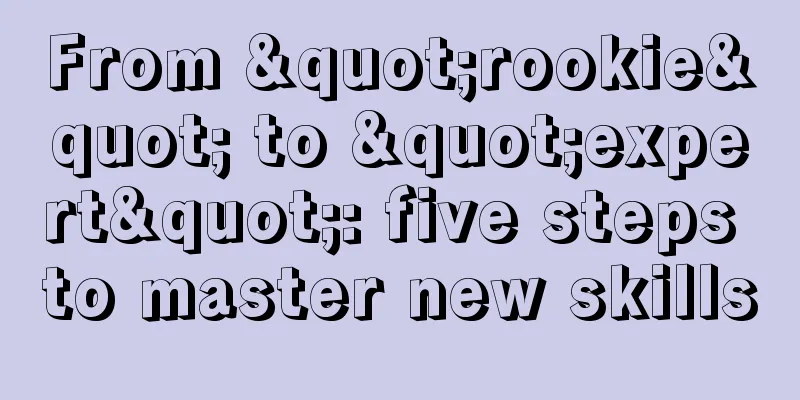From "rookie" to "expert": five steps to master new skills

In this fast-changing era, learning new skills is like adding to life, opening doors full of possibilities for us. Every time we decide to learn a new skill, whether for career development, personal interest, or pure curiosity, we are actually adding a colorful touch to our lives. But learning new skills is not always smooth sailing. Sometimes it is like climbing a steep mountain, requiring perseverance and strategy. So, how can you grow from a beginner to an expert? This is the topic we want to explore this time. In this article, we will walk through the five steps to master a new skill. 1. Know yourself and identify your goalsSelf-assessment of personal abilities Before you start your journey of exploring new skills, imagine yourself as a ship that is about to set sail. You need to know, what equipment is on board? Which are the latest radars, and which are the old power systems that need to be repaired? This is not only an inventory of your current skills, but also a deep insight into your own strengths and weaknesses. Just like a doctor diagnoses a condition before prescribing medicine, we need to have a comprehensive understanding of ourselves before we set sail to learn. This process can be completed through self-reflection, or by seeking feedback from colleagues and superiors. The key is to diagnose neither too confidently nor too self-deprecatingly. Next, let's look at some personal ability assessment tools on the market, just like different types of navigation instruments:
Using these tools is like having a comprehensive preparation checklist for your sailing trip. Most importantly, be honest with the feedback and use the information you gain to develop a practical plan for improvement. Clarify learning objectives In the ocean of the workplace, learning without a goal is like a ship without a compass. It may drift anywhere or even go in circles. Setting clear learning goals is like equipping your ship with a navigation system, which can ensure that you are heading in the right direction in the ocean of knowledge. Without a goal, you may drown in the ocean of short videos. When setting learning goals, the SMART goal rule is your good helper. It stands for Specific, Measurable, Achievable, Relevant, and Time-bound goals. For example, transforming "improve Excel skills" into "complete advanced Excel data analysis courses within three months" is like upgrading from "I want to get healthier" to "I plan to run three times a week for 30 minutes each time." When setting learning goals, think about each move like playing chess. Ask yourself: How will this goal help me achieve my career dream? If your goal is to become a data analyst, then learning Python is more in line with your career roadmap than learning to make short videos (unless your dream is to become a video blogger). This is not only about the specific content of learning, but also about how to make the learning outcomes resonate with your career vision. 2. Choose the right learning resourcesAfter determining your learning goals, the next step is to choose the right tools and resources. This step is like choosing the right equipment for a trip. The right choice can make the journey smoother. Resource screening and selection First of all, you need to realize that not all learning resources are suitable for you. In this era of information explosion, choosing the right resources from a vast number of books and online courses has become a key task. There are several aspects to consider: Is the resource targeted at your learning goals? Is it suitable for your learning style (for example, do you prefer video tutorials or text instructions)? Is it within your time and financial budget? If you want to find a learning method that suits you, you can refer to the VARK model. The VARK model was proposed by New Zealand educator Neil Fleming, which divides learners into four types: visual, auditory, reading and writing, and hands-on.
Knowing your VARK type is like knowing your own learning language. If you are a visual learner, watching videos may be more effective than listening to lectures; if you are a hands-on learner, actual operations may be more helpful than reading. Knowing your VARK type can make your learning journey more efficient and smoother. To find out your VARK type, you can search for VARK questionnaires. There are many such online questionnaires on the Internet. In addition to learning preferences, factors such as time and budget will affect the type of learning resources that are most suitable for them. For example, full-time workers may prefer flexible online courses, while students or part-time workers may have more time to participate in face-to-face tutoring. The following is a table of recommended learning resources based on different learning preferences, time schedules, and budgets: This table provides a guide for selecting learning resources based on different factors such as learning preferences, time schedule and budget. Of course, these are just suggestions and their suitability may vary depending on individual circumstances. It is important to find the learning resources that best suit your individual needs and conditions. 3. Develop a study plan and implement itWith a clear goal and the right learning resources, now you need a practical action plan. Creating a study plan is like drawing a map that will guide you towards your goal. An effective study plan should include specific learning activities, a scheduled schedule, and how to monitor progress and effectiveness. For example, if your goal is to improve your public speaking skills, your plan might include watching two TED talks per week, attending a public speaking training class every two weeks, and practicing your speech in a group meeting once a month. There are many effective methods and strategies for developing a study plan, many of which are based on academic research and professional books. Here are some of the main methods and examples: (1) SMART goal setting Method description: SMART is a goal-setting framework, which stands for Specific, Measurable, Achievable, Relevant, and Time-bound. Applying the SMART principle in your learning plan means that your learning goals should be clear, quantifiable, feasible, relevant, and have a clear completion time. Example Application: For example, a SMART learning goal might be: "Spend 10 hours per week over the next three months learning to code in order to complete a basic personal project." (2) Distributed practice Method description: Distributed practice, also known as spaced repetition, refers to reviewing learning content over a longer period of time. This is consistent with psychologist Ebbinghaus's research on the forgetting curve, which shows that information will be remembered more effectively if it is reviewed again after a period of time. Example application: For example, when making a study plan, you can arrange to review previously learned content at least twice a week instead of learning all the content at once. (3) Active learning strategy Description of method: Active learning involves students actively participating and thinking in the learning process rather than passively receiving information. This includes strategies such as asking questions, summarizing, and teaching others. Example application: Your study plan could include weekly discussions with your peers about the course content, or you could try to teach what you’ve learned to others to deepen your understanding and retention. (4) Bombardier Training Method Description of the method: The Bombardier method involves breaking work time into 25-minute blocks (a "pomodoro"), followed by a 5-minute break. This method can improve focus and efficiency. Example application: In your study plan, you can arrange one or more "Pomodoro" time blocks for each study task to stay efficient and focused. (5) Metacognitive strategies Method Description: Metacognition is the knowledge and regulation of one's own thinking processes. Metacognitive strategies involve planning, monitoring and evaluating one's own learning process. Example application: Your study plan could include regular self-assessment, such as reviewing what you have learned and adjusting your study methods or plan each week. Once you have a plan, it’s all about execution. This requires discipline and motivation, but also flexibility. Don’t be afraid to make adjustments if you find that something doesn’t fit or isn’t working as well as you’re doing. Maybe you find that an online course isn’t as effective as hands-on practice, or that you need more time to master a certain skill. 4. Practice for feedback“My head feels like it, but my hands haven’t!” This may be a true reflection of many people who learn a new skill. But don’t worry, you are not alone. This is exactly what we are talking about - transferring knowledge through practice and learning from it. A neuroscience study found that when we actually do something, the areas of the brain responsible for movement and memory become more active. Researchers asked a group of people to learn piano. Some people just watched the tutorial, while others actually played. The results showed that those who actually did it not only learned faster, but also remembered it better. What does this mean? Simply put, when you do something yourself, your brain is actually helping you "remember" the skill. In the process of practice, effective feedback is a catalyst for growth. Recall the first time you cooked, you followed the recipe step by step, but the result was a dark dish. Yes, we have all experienced similar things. But making mistakes is not terrible, these mistakes are actually valuable learning resources. Every mistake is an opportunity to learn and grow. Making mistakes is good feedback, which will make you remember the mistakes more deeply. Learning through practice not only makes theoretical knowledge come alive, but also helps us to deeply understand and master skills. Remember, every practice, whether successful or failed, is an important step on the road to becoming a master. 5. Continuous progress and reflectionImagine that you are climbing a mountain of knowledge and suddenly you find that the top of the mountain is actually the starting point of a higher mountain. The learning journey is like this, it never ends. It is important to review your learning and practice regularly. You can set a self-assessment periodically (such as every quarter or every six months). During this process, ask yourself a few questions: Did I achieve the learning goals I set earlier? What challenges did I encounter in my actual application? How did I overcome these challenges? This self-assessment not only helps you identify your progress, but also reveals potential directions for future learning and development. We should review our plans regularly because we often find that the goals we set are no longer applicable when we are halfway through. For example, according to data from the Project Management Institute of the United States, more than 31% of projects cannot be completed on schedule. Nearly one-third of company-level projects cannot be completed on schedule. If there is no one to supervise and collaborate on personal learning plans, it will definitely be more difficult to complete them. When we first set goals, we look at the future from the perspective of our current level of cognition. After a period of cognitive iteration, you may find that the original goal is too narrow. For example, when I just graduated, my goal was to have a monthly salary of over 10,000 yuan in the future. After a few years, I realized that this goal was too low. As long as you go to a big city and your monthly salary is less than 10,000 yuan, you can't survive. At this time, the approach is definitely not to lie down, but to modify the unreliable goal. By continuously evaluating and correcting goals, and continuing the cycle, each cycle can make you a better self. We need to maintain curiosity and enthusiasm for learning, and constantly look for new opportunities and challenges in the workplace and in life. Conclusion: Learning is a continuous journeyAfter learning, practicing, applying and reflecting on the previous five modules, we can easily find that learning is not only a process to achieve a goal, but also a continuous lifestyle. In the workplace, constantly learning new skills, accepting new ideas, and adapting to new changes are the keys to maintaining competitiveness and achieving personal development. Finally, let’s end this learning journey with a question: What is your next learning goal and how do you plan to achieve it? Author: Jason Source: WeChat public account "Sanyuan Variance (ID: sanyuanfangcha)" |
<<: Bonus inside | Uncover Huawei's APP message push strategy, easily achieve user growth
Recommend
Sell out the brand
What is the secret of brand marketing? Can excelle...
eBay sneaker sellers will get FedEx shipping labels
eBay US announced that it will work with FedEx to ...
Taobao corrects its policy and allows merchants to say no to unreasonable “refund only” policies
On the platform of e-commerce giant Taobao, the ba...
As 618 approaches the middle, what changes are revealed behind the pre-sale battle reports of various platforms?
The 618 promotion is halfway through, and major e-...
What is the Japanese language proficiency required for Amazon Japan? What is CSBA?
If domestic sellers want to do well in cross-borde...
Is it possible to grow by adding new features? Why not dig for treasures from old features?
Analyze user behavior, identify key features, opti...
Is Shopee a scam? Is it a pyramid scheme?
Currently, you do not need to pay platform usage f...
The more traffic you have, the faster you die? 5 cases showing the "counterintuitive" growth path
In the new consumption era, how can brands find a ...
How to improve the store ranking of Wish? How to improve the ranking of Wish
Wish is an emerging mobile e-commerce company. The...
What are the requirements for Amazon video ads? How to upload them?
Now after opening a store on Amazon, everyone will...
Does Amazon Video Delivery cost money? How do I deliver videos?
In the tide of digital marketing, video has become...
How brands create buzz
In this era, topics have become as indispensable a...
How many steps will Douyin's 4 trillion yuan e-commerce be divided into?
This article introduces Douyin's new e-commerc...
AI Taobao store, after 2 months of operation
Lumi Micro Store was founded in April 2022, and ha...
User pain points: How to make users want to buy?
Accurately grasping the user's pain points is ...









